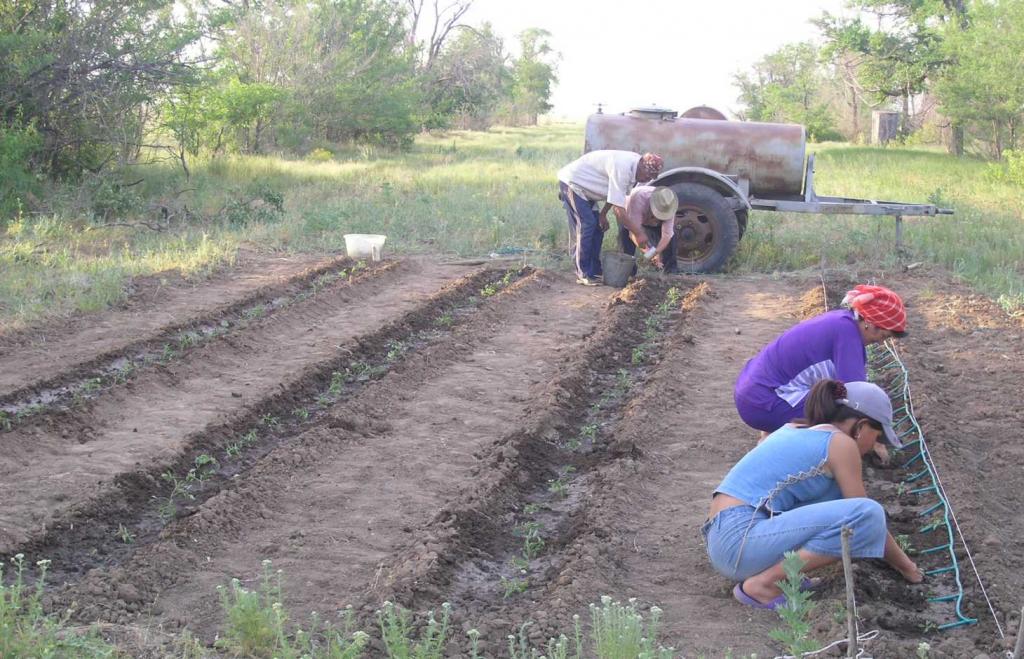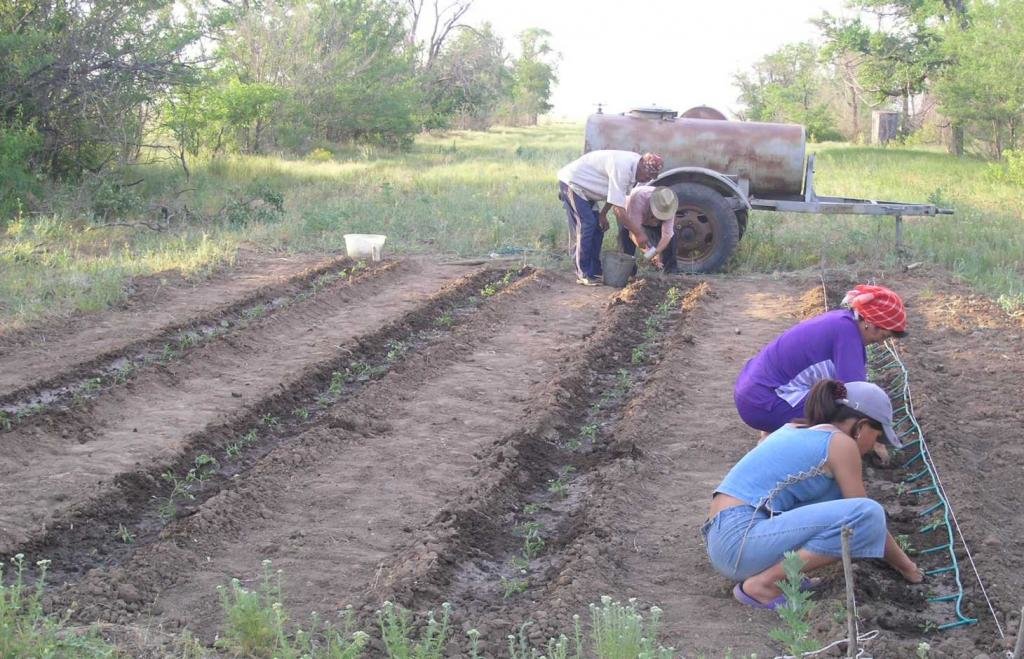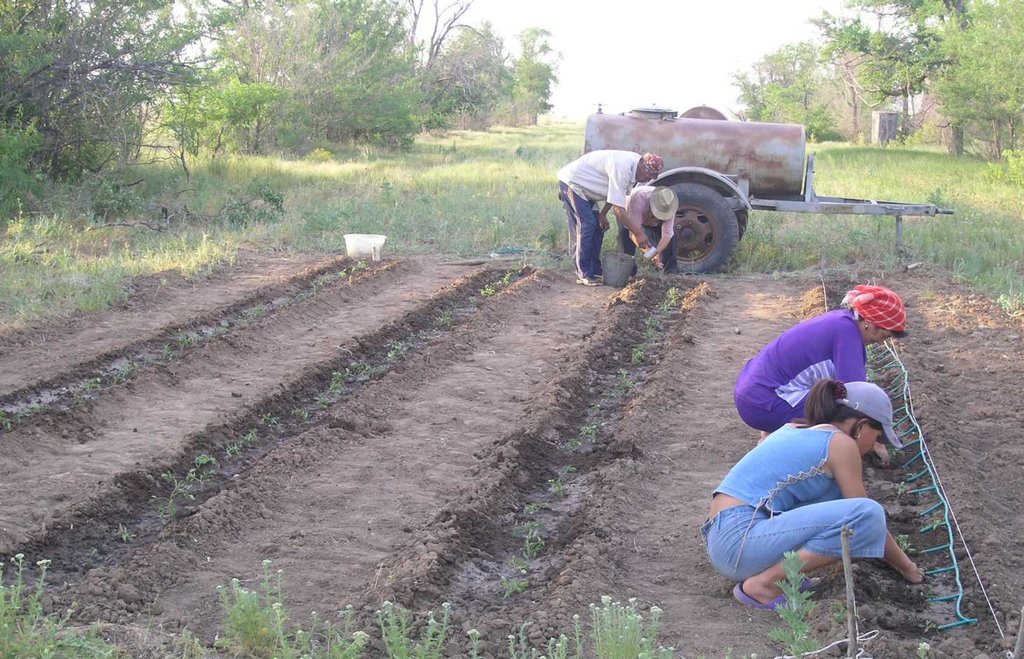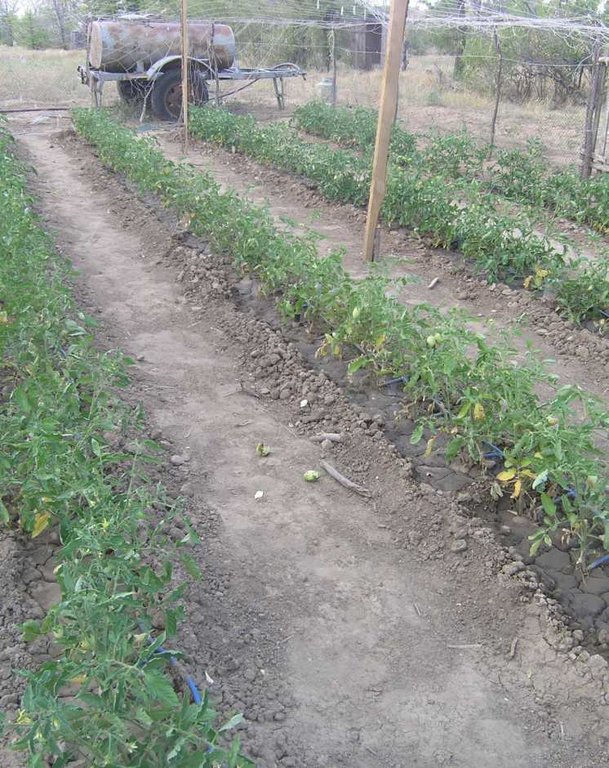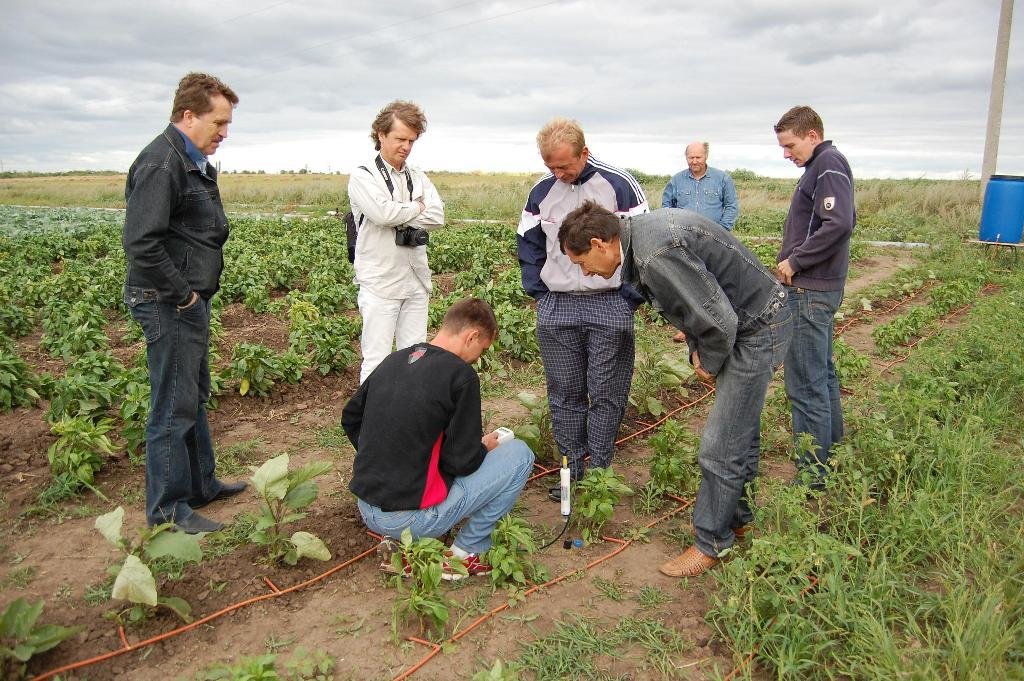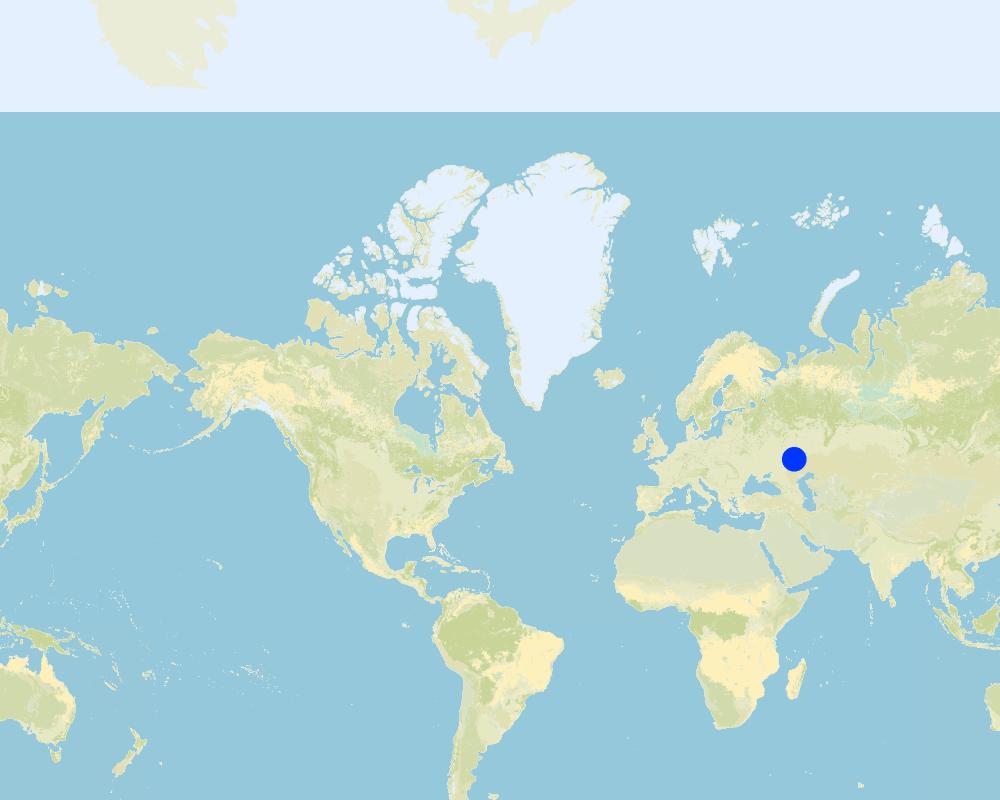Concerted thinking on common problems of water scarcity [俄罗斯联邦]
- 创建:
- 更新:
- 编制者: Anatoly Zeyliger
- 编辑者: –
- 审查者: David Streiff
Жить рядом – думать об общей воде (Russian)
approaches_2426 - 俄罗斯联邦
查看章节
全部展开 全部收起1. 一般信息
1.2 参与方法评估和文件编制的资源人员和机构的联系方式
有助于对方法进行记录/评估的项目名称(如相关)
DESIRE (EU-DES!RE)有助于对方法进行记录/评估的机构名称(如相关)
Moscow State University of Environmental Engineeri (Moscow State University of Environmental Engineeri) - 俄罗斯联邦1.3 关于使用通过WOCAT记录的数据的条件
(现场)数据是什么时候汇编的?:
27/02/2009
编制者和关键资源人员接受有关使用通过WOCAT记录数据的条件。:
是
1.4 SLM技术问卷的参考
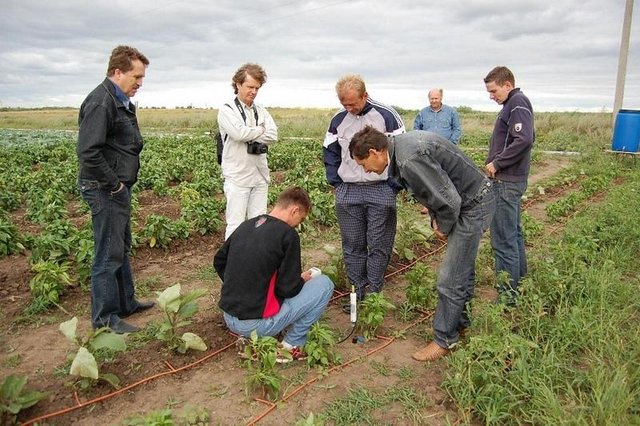
Drip irrigation [俄罗斯联邦]
Drip irrigation systems gradually apply water into the zone around the stem of the irrigated plant.
- 编制者: Anatoly Zeyliger
2. SLM方法的描述
2.1 该方法的简要说明
Testing and disseminating of a water-saving technology like drip irrigation
2.2 该方法的详细说明
该方法的详细说明:
Aims / objectives: The objective of the Rural Development Programme (RDP) is to assist farmers who have to deal with difficult environmental conditions (drought, steep slopes) in applying sustainable farming practices either at the implementation phase or for maintenance. The programme is carried out to: 1) improve the socio-economic conditions of rural areas; 2) prevent land abandonment, and 3) prevent on-site and off-site damage caused by land degradation and erosion. To achieve these objectives, the RDP identifies different lines of action: 1) compensation for difficult natural conditions; 2) combating erosion; 3) reducing farming intensity; and 4) promoting eco-friendly agricultural practices.
Methods: The main method used in RDP is to provide farming subsidies for farming practices following a cross-compliance principle. Each line of action implies a combination of conservation measures that are subsidised, but only when applied in combination. Hence, single conservation measures outside of these lines of action are not subsidised.
Stages of implementation: Two years of testing with following phase of result dissemination.
Role of stakeholders: The level of subsidy is based on estimated implementation and maintenance costs and possible loss of productivity caused by the conservation measures. These values were obtained after consultation with various stakeholder groups including farmer organisations with agricultural cooperatives. However, because of limited resources, not all farmers will receive subsidies for conservation measures. Priority is given to: 1) farmers who have 50% of their land within the Nature 2000 network, a European-wide network of protected areas for the preservation of habitats and threatened species; 2) farmers with >50% of their land in unfavourable zones; and 3) farmers who did not receive subsidy in previous RDPs.
Other important information: Furthermore, areas with slopes of more than 20% are not subsidised in this programme since it is recommended that no agriculture should take place. Instead, reforestation of these areas is subsidised. RDPs are developed for a period of seven years. At the end of this period, a new RDP is defined and priorities and levels of subsidies may be changed. The present RDP is valid for the period 2007-2013
2.3 该方法的照片
2.5 采用该方法的国家/地区/地点
国家:
俄罗斯联邦
区域/州/省:
Russia
有关地点的进一步说明:
Pallasovsky district, Volgograd region
Map
×2.6 该方法的开始和终止日期
注明开始年份:
2002
终止年份(若不再采用该方法):
2011
2.7 方法的类型
- 基于项目/方案
2.8 该方法的主要目的/目标
The Approach focused on SLM only
To consider the common problems of water scarcity at villages remote from water sources. To provide the best examples of water usage and initiate implementation of water-saving technologies.
The SLM Approach addressed the following problems: The main problem to be addressed by this approach is the conflicts over the common use of water supplied to the villages. In this dry area, water is scarce and has to be brought from remote rivers, lakes and artificial water storage facilities through irrigation channels. In the dry season, when water demand exceeds availability, there is a pivotal problem of poor water availability for all villagers. During the most difficult period, water even has to be transported to the villagers’ houses by car.
2.9 推动或妨碍实施本办法所适用的技术的条件
社会/文化/宗教规范和价值观
- 阻碍
People do not know much about water-saving technologies. Whatever they learn about it, they are convinced that it is very complicated or too costly.
Treatment through the SLM Approach: Organization of training seminars, sharing ideas between farmers
法律框架(土地使用权、土地和水使用权)
- 阻碍
The existing land ownership, land use rights / water rights moderately hindered the approach implementation
3. 相关利益相关者的参与和角色
3.1 该方法涉及的利益相关者及其职责
- 当地土地使用者/当地社区
Testing of drip irrigation on their subsidiary plots, participation in monitoring activities, training and dissemination.
Owing to simple installation and control of drip irrigation, it is promising that disadvantaged people grow vegetables and fruits for their own consumption in order to improve their income and to save water for domestic use.
- 社区组织
Collective farmers are involved in approach for future implementation of it at vegetable plantation
- SLM专家/农业顾问
Agronomists as well as reseachers were involved in this approach by development scheme of applications, advising people.
- 国家政府(规划者、决策者)
Administration of the region was informed about DESIRE project activities. It supports the activities by giving advice, introduction to useful people.
3.2 当地土地使用者/当地社区参与该方法的不同阶段
| 当地土地使用者/当地社区的参与 | 指定参与人员并描述活动 | |
|---|---|---|
| 启动/动机 | 互动 | SLM specialists - introducing the technology to people Planners - introducing the technology to people ready for testing it |
| 计划 | 互动 | SLM specialists - planning of test implementation Land users - agreement to test the technology |
| 实施 | 外部支持 | SLM specialists – implementation of schemes development Land users – preparation of experimental plots |
| 监测/评估 | 外部支持 | Land users - simple monitoring of drip irrigation system performance |
| Research | 外部支持 | Land users – reporting of water used for irrigation, workload and harvested yield |
3.4 有关SLM技术选择的决策
具体说明谁有权决定选择要实施的技术:
- 主要是SLM专家,咨询土地使用者之后
解释:
Within the DESIRE project field trip several meetings with stakeholders were performed. Different variant were discussed. Local land users mentioned the technology of drip irigation and ask help of expert in implementation and training.
Decisions on the method of implementing the SLM Technology were made by mainly by land users supported by SLM specialists. Method was chosen as it is saving water resources and labour time, is suitable for the local conditions and not complicated to implement.
4. 技术支持、能力建设和知识管理
4.1 能力建设/培训
是否为土地使用者/其他利益相关者提供培训?:
是
明确受训人员:
- 土地使用者
培训形式:
- 示范区域
- 公开会议
涵盖的主题:
drip irrigation technology, knowledge about varying quantities for plants during the growing season according to the hydrological cycle, etc.
4.2 咨询服务
土地使用者有权使用咨询服务吗?:
是
指明是否提供了咨询服务:
- 在土地使用者的土地上
说明/注释:
Name of method used for advisory service: Drip irrigation technology; Key elements: Water cycle: elaborated and explained to stakeholders during an initial stakeholder workshop as well as during field visits, Water-saving technologies: explained to stakeholders during stakeholder workshops. They were based on conceptual approaches and data gathered during field monitoring
Advisory service is quite adequate to ensure the continuation of land conservation activities; The government cannot provide special services in order to ensure its continuation; however, farmer-to-farmer dissemination is working.
4.3 机构强化(组织发展)
是否通过这种方法建立或加强了机构?:
- 是,适度
具体说明机构的强化或建立程度:
- 本地
具体说明支持类型:
- 能力建设/培训
提供进一步细节:
The local administration organized some demonstration and training activities for local users.
4.4 监测和评估
监测和评估是该方法的一部分吗?:
是
注释:
Bio-physical aspects were ad hoc monitored by government through measurements; indicators: through farm visits and sampling of soils for chemical parameters (for example to control for ecological farming practices)
Technical aspects were ad hoc monitored by land users through observations; indicators: Comparison of water consumption using drip irrigation and furrow irrigation. The very high water efficiency as well as the minimal rate of water used for crop growing by drip irrigation was clearly demonstrated.
Economic / production aspects were monitored through measurements; indicators: by comparing production between years
There were no changes in the Approach as a result of monitoring and evaluation
There were several changes in the Technology as a result of monitoring and evaluation: Some changes were made as a result of bio-physical monitoring of plant development according to water quantities, fertilizer application, etc.
4.5 研究
研究是该方法的一部分吗?
是
明确话题:
- 技术
提供进一步的细节,并指出是谁做的研究:
The implementation of drip irrigation technology under local conditions was performed by a team from the Moscow State University of Environmental Engineering under the framework of the EU-DESIRE project.
Research was carried out both on station and on-farm
5. 融资和外部物质支持
5.1 该方法中SLM组成部分的年度预算
如果不知道准确的年度预算,请给出一个范围:
- 2,000-10,000
注释(例如主要的资助来源/主要捐助者):
Approach costs were met by the following donors: international non-government (EU research project DESIRE): 100.0%
5.2 为土地使用者提供财政/物质支援
土地使用者是否获得实施该技术的财政/物质支持?:
是
如果是,请具体说明支持的类型、条件和提供者:
Agricultural activities are subsidised by government
5.3 对特定投入的补贴(包括劳动力)
- 设备
| 具体说明哪些投入得到了补贴 | 程度如何 | 对补贴做出具体说明 |
|---|---|---|
| 机械 | 充分融资 | |
| 工具 | 充分融资 | |
如果土地使用者的劳动力是一项重要的投入,那么是不是:
- 获得其他物质支持
注释:
Materials (pipes for irrigation system, water tank) for the implementation of the experimental plots were supplied to land users. Some of the land users’ activities, like monitoring of soil water capacity, were paid with small amounts of cash. Other work was implemented voluntarily.
As this drip irrigation is in a testing phase, the materials for the irrigation system were financed by the project and not by the land users.
Labour was also paid in cash or sometime it was voluntarely.
5.4 信用
是否根据SLM活动的方法给予信用值?:
否
6. 影响分析和结论性陈述
6.1 方法的影响
该方法是否帮助土地使用者实施和维护SLM技术?:
- 否
- 是,很少
- 是,中等
- 是,支持力度很大
decreased water use
该方法是否有助于社会和经济弱势群体?:
- 否
- 是,很少
- 是,中等
- 是,支持力度很大
It enables people with low income to avoid having to buy vegetables in the market by growing them for their own use and for sale.
Did other land users / projects adopt the Approach?
- 否
- 是,很少
- 是,中等
- 是,支持力度很大
Land users share their knowledge and experience with each other. Where this occurs, drip irrigation disseminates amongst the stakeholders.
Did the Approach lead to improved livelihoods / human well-being?
- 否
- 是,很少
- 是,中等
- 是,支持力度很大
Possibilities to grow vegetables, to increase their income and to diversify their food.
Did the Approach help to alleviate poverty?
- 否
- 是,很少
- 是,中等
- 是,支持力度很大
The practice allows people to produce food on their subsidiary plots.
6.2 土地使用者实施SLM的主要动机
- 增加生产
by using this technology people can increase food production.
- well-being and livelihoods improvement
People want to save water, but also to improve their well-being
6.3 方法活动的可持续性
土地使用者能否维持通过该方法实施的措施(无外部支持的情况下)?:
- 是
6.4 该方法的长处/优点
| 土地使用者眼中的长处/优势/机会 |
|---|
| increasing the well-being of people (How to sustain/ enhance this strength: Table of land users become more rich by vegetable, some vegetables can be sold on the market) |
| Labour time saving (How to sustain/ enhance this strength: Giving people more time for others activities) |
| water saving (How to sustain/ enhance this strength: Implementation of water saving technologies) |
| 编制者或其他关键资源人员认为的长处/优势/机会 |
|---|
| Increasing the well-being of people: food availability for land users becomes enriched in terms of vegetables and some vegetables can be sold on the market (How to sustain/ enhance this strength: Dissemination of these opportunities to other people) |
| Reduction of labour input (How to sustain/ enhance this strength: Giving people more time for other activities) |
| Combating land degradation (How to sustain/ enhance this strength: sharing this knowledge with other users) |
| Sharing water-saving knowledge with other users (How to sustain/ enhance this strength: Implementation of water-saving technologies and dissemination of these skills to neighbours.) |
| Concerted thinking by stakeholders on common problems of water scarcity in villages remote from water sources (How to sustain/ enhance this strength: Provide best-practice examples of water usage and initiate implementation of water-saving technologies ) |
6.5 该方法的弱点/缺点以及克服它们的方法
| 编制者或其他关键资源人员认为的弱点/缺点/风险 | 如何克服它们? |
|---|---|
| Relatively high starting implementation costs |
7. 参考和链接
7.1 方法/信息来源
- 实地考察、实地调查
- 与土地使用者的访谈
7.2 参考可用出版物
标题、作者、年份、ISBN:
Zeiliguer, A., G. Sokolova, V. Semeonv, O. Ermolaeva. Results of field experimentations at 2008 to grow tomatoes under drip irrigation at Pallasovsky District of Volgograd Region. Proceeding of conference at MSUEE. 2008, p. 45-56
链接和模块
全部展开 全部收起链接

Drip irrigation [俄罗斯联邦]
Drip irrigation systems gradually apply water into the zone around the stem of the irrigated plant.
- 编制者: Anatoly Zeyliger
模块
无模块


